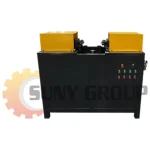In the rapidly growing metal recycling industry, efficiency, precision, and safety are everything. Among the tools that have transformed compressor recycling, the Compressor Shell Cutter stands out as a true game-changer. Whether you’re dealing with air conditioner compressors, refrigerator units, or automotive components, this machine enables you to cut open and process sealed compressor shells effortlessly, recovering valuable copper, aluminum, and steel in minutes.
If you’re wondering what a compressor shell cutter is, how it works, and why it’s becoming indispensable for recycling operations, this blog has you covered.
What Is a Compressor Shell Cutter?
A Compressor Shell Cutter is a specialized industrial machine designed to cut or split open sealed compressor casings. These casings, usually made of thick steel, encase valuable components such as copper windings, aluminum coils, and motor stators. The cutter’s purpose is to safely and efficiently separate the metal housing from the internal parts without causing damage or material loss.
Modern compressor shell cutters are hydraulic-powered and use high-torque blades or shearing jaws to slice through metal with precision. The result? High-quality metal recovery and faster processing times compared to manual cutting or torch methods.
Why Is Compressor Shell Cutting Important?
The global demand for metal recycling continues to rise. According to industry data, metal recycling reduces energy consumption by up to 75% compared to producing metals from raw ore. Compressors, found in millions of discarded air conditioners and refrigerators, represent a rich source of recyclable materials.
However, the shells are tough, sealed, and pressurized — making manual dismantling dangerous and time-consuming. The Compressor Shell Cutter eliminates these challenges by automating the process, enhancing both efficiency and operator safety.
Key benefits include:
Higher recovery rates: Extracts copper, aluminum, and steel with minimal loss.
Improved safety: Reduces the risk of explosions and injuries from gas or oil residues.
Time savings: Processes dozens of compressors per hour.
Lower operational costs: Minimizes labor and cutting tool expenses.
Cleaner recycling workflow: Reduces contamination and improves sorting efficiency.
How Does a Compressor Shell Cutter Work?
Most compressor shell cutters operate using hydraulic pressure to drive a cutting blade or shear through the metal casing. The process typically involves:
Positioning: The compressor is clamped securely into the cutting area.
Cutting: A high-force hydraulic blade slices through the steel shell, exposing the internal copper and aluminum parts.
Separation: The valuable materials are easily removed for further processing or resale.
Depending on the model, machines may feature single-blade cutters, dual-head shears, or even rotary cutting systems. Some advanced models can automatically adjust for different compressor sizes, improving versatility.
Advantages of Using a Compressor Shell Cutter in Recycling
Implementing this machine in your recycling line offers several measurable benefits:
Productivity boost: Process up to 60 compressors per hour.
Environmental impact reduction: Cleaner dismantling means fewer pollutants.
Long equipment life: High-strength steel blades withstand years of industrial use.
ROI within months: Due to high metal recovery and reduced labor costs.
Scalable operation: Ideal for both small recycling shops and large industrial facilities.
In today’s recycling world, speed and safety define success. The Compressor Shell Cutter is more than just a machine—it’s a strategic investment for anyone looking to maximize metal recovery, streamline operations, and reduce risks.
